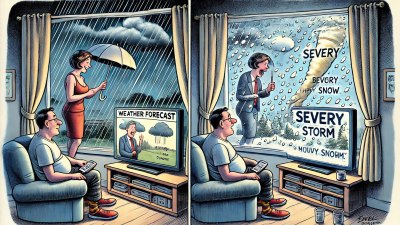The Emotional Climate of That Group Chat You Never Leave
Explore the emotional dynamics shaping the group chat you stay in, from humor to conflicts and digital social bonding.

Group chats have become one of the most prevalent forms of communication in the digital age. These virtual spaces are more than just venues for sharing memes or arranging plans; they serve as dynamic ecosystems reflecting complex emotional climates. The emotional atmosphere of a group chat can significantly influence how members interact, develop relationships, and perceive the collective identity of the group.
Understanding the emotional climate of a group chat is crucial because it affects member engagement and the overall satisfaction people derive from participation. Emotional climate refers to the shared mood, feelings, and tone that emerge from the interactions within the chat. This climate is shaped by various factors including the nature of conversations, frequency of interactions, communication styles, and individual personalities.
How Emotional Climate Develops in Group Chats
The emotional climate in any group chat emerges gradually as members exchange messages. Early interactions set the tone, establishing behavioral norms and expectations. For instance, a group chat that begins with lighthearted banter is likely to maintain a more relaxed atmosphere, whereas one focused on professional or academic discussions may adopt a formal tone.
Active participants often have a significant impact. Those who frequently share positive messages, humor, or encouragement help cultivate a welcoming and upbeat environment. Conversely, members who engage in criticism, sarcasm, or negativity can create a tense or hostile climate. The balance between these opposing emotional expressions frequently determines the group chat’s overall atmosphere.
Common Emotional Patterns in Group Chats
Many group chats exhibit recognizable emotional patterns, which can be identified through the tone of communication and behavior of participants. Some common patterns include:
- Humor-Driven Atmospheres: These are characterized by jokes, memes, and playful teasing. They often foster camaraderie and make the chat enjoyable and a source of relaxation.
- Supportive Environments: In these chats, members offer empathy, advice, and encouragement. Emotional support strengthens bonds and fosters trust.
- Conflict-Prone Dynamics: These chats occasionally experience misunderstandings, disagreements, or heated debates. The emotional climate can fluctuate between tension and attempts at resolution.
- Informative and Task-Focused Moods: Some groups maintain a pragmatic tone, focusing on goals like project coordination or sharing news.
Recognizing these patterns helps members navigate the social terrain of the group chat more effectively.
The Role of Humor and Sarcasm
Humor often acts as the glue binding members of a group chat together. It lightens serious moments, diffuses tension, and provides entertainment. Memes, inside jokes, and witty remarks create a shared culture unique to that chat. Participants who master the art of timely humor usually become popular within the group.
However, humor can be double-edged. Sarcasm, while entertaining to some, may be misunderstood or perceived as offensive by others. The absence of vocal tone and facial expressions in text communication makes interpreting sarcasm challenging, potentially leading to miscommunication and conflict. Navigating this requires sensitivity, clear context, and sometimes explicit clarifications to maintain harmony.
Emotional Boundaries and Privacy
Group chats often blur the lines between public and private communication. Members might share personal experiences, emotions, or confidences, expecting a safe space. When privacy boundaries are respected, the emotional climate is generally trusting and open. Yet breaches of confidence or inappropriate sharing can cause distrust and withdrawal.
Balancing openness with discretion is critical. Some participants self-censor to maintain privacy or avoid judgment, which can affect the emotional richness of conversations. In contrast, environments with strong respect for boundaries foster deeper connections.
Managing Conflict within Group Chats
Even the closest group chats occasionally encounter conflict. Disagreements may arise from differing opinions, misinterpretations, or clashing personalities. How these conflicts are addressed significantly influences the group’s emotional health.
Healthy conflict management involves active listening, empathy, and clear communication. Groups that encourage open dialogue and resolution cultivate a resilient emotional atmosphere. Conversely, unresolved tension or toxic behaviors can lead to fragmentation, reduced participation, or even dissolution of the group.
Digital Empathy and Emotional Intelligence
Emotional intelligence—the ability to perceive, understand, and manage emotions—is vital for cultivating a positive emotional climate in group chats. Digital empathy requires interpreting messages carefully and responding thoughtfully, despite the lack of face-to-face cues.
Members who exhibit high emotional intelligence often mediate conflicts, reinforce positive interactions, and elevate the overall conversational quality. Their interventions can foster inclusion and encourage quieter members to participate.
The Impact of Frequency and Volume of Messages
The frequency and volume of messages contribute strongly to the emotional tone. An overwhelming flow of messages might induce stress or fatigue, leading to disengagement, while infrequent communication can make the chat feel dull or disconnected.
Managing message flow is often a collective effort. Participants may create “quiet hours” or limit off-topic posts to maintain balance. Moderators, when present, play an important role in regulating conversations, setting guidelines, and promoting respectful exchanges.
Technology’s Influence on Emotional Dynamics
Features embedded within messaging platforms influence how emotions are expressed and perceived. Emoji, GIFs, and reaction features add nuance and help clarify tone. For example, a message might seem blunt in plain text, but a smiley emoji can soften the impression.
Conversely, the absence of nonverbal cues limits emotional richness. This constraint can sometimes cause misunderstandings or cause members to be more cautious in their communication. The design and affordances of the chat platform thus partially shape the emotional climate.
The Role of Power and Hierarchies
Even within seemingly informal group chats, social hierarchies and power dynamics exist. Members who are older, more influential, or more active may set the norms and emotional tone. Their approval or disapproval can affect others’ willingness to contribute.
Dominant voices can either uplift the group or suppress dissent. Awareness of these dynamics allows participants to foster inclusivity and encourage balanced participation, promoting a healthier emotional environment.
Attachment and Identity Formation
Over time, group chats can become central to identity and belonging for members. They offer a sense of community and an arena to express multiple facets of self. The emotional climate supports this process by validating feelings and experiences.
Members often develop attachment to the group, leading to consistent participation despite occasional conflicts or annoyances. This attachment further reinforces the chat’s emotional atmosphere, creating a feedback loop between individual emotions and group mood.
Generational and Cultural Factors
Emotional expression varies across generations and cultures within group chats. Younger members might use more slang, emojis, or playful language, while older participants could prefer formality and restraint.
Cultural norms influence how emotions are shared or suppressed. Sensitivity to these differences improves mutual understanding and minimizes misinterpretations. Successful group chats often evolve norms that blend diverse emotional styles harmoniously.
Psychological Benefits and Risks
Participating in a group chat with a positive emotional climate can offer significant psychological benefits. It can reduce feelings of loneliness, provide emotional outlets, and promote social skill development. The instant nature of messaging creates an accessible support system anytime.
Conversely, toxic emotional climates may exacerbate stress, anxiety, or feelings of exclusion. Persistent negativity can affect self-esteem and discourage participation, highlighting the importance of maintaining a healthy environment.
Strategies for Enhancing Emotional Climate
Improving the emotional atmosphere requires intentional effort. Some strategies include:
- Setting clear guidelines for respectful communication.
- Encouraging positivity and recognition of contributions.
- Promoting empathy and active listening.
- Addressing conflicts promptly and constructively.
- Utilizing humor carefully to foster joy without offending.
- Being mindful of privacy and confidentiality.
- Balancing message volume to prevent fatigue.
- Including diverse voices and perspectives.
When these practices are applied, the group chat evolves into a vibrant space where emotional expression enriches connection.
Case Studies and Real-World Examples
Consider a college friend group chat where humor and nostalgia dominate the emotional climate. Members share memes about inside jokes and reminisce about shared experiences, creating a warm, playful atmosphere that reinforces their bonds despite geographic distance.
Contrast this with a work team’s group chat, which might be more focused on task-related communication with occasional supportive messages. The climate here balances professionalism with moments of camaraderie to reduce stress during deadlines.
In contrast, some group chats suffer emotional decline due to unresolved conflicts or dominance by negative voices. Members withdraw, the conversation becomes stale or tense, and in some cases, the group disbands.
Future Directions: The Evolution of Group Chat Emotional Dynamics
Technological advancements such as artificial intelligence and deeper integration of multimedia will continue to shape emotional communication in group chats. Automated sentiment analysis and moderation could enhance emotional balance by alerting members to negative trends or offering suggestions for tone adjustments.
Virtual reality and augmented reality may introduce richer emotional cues into digital interactions, bringing group chats closer to face-to-face communication experiences. These developments promise to enhance empathy and emotional depth in virtual communities further.
Ultimately, the emotional climate of that group chat you never leave is a living entity shaped by its members’ shared expressions, experiences, and care. Its health mirrors the quality of the social bonds it nurtures, making it a vital cornerstone of digital social life.











